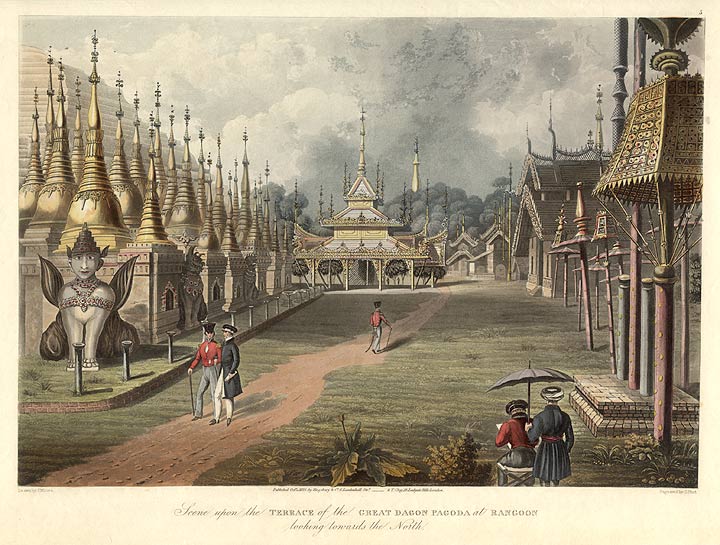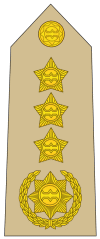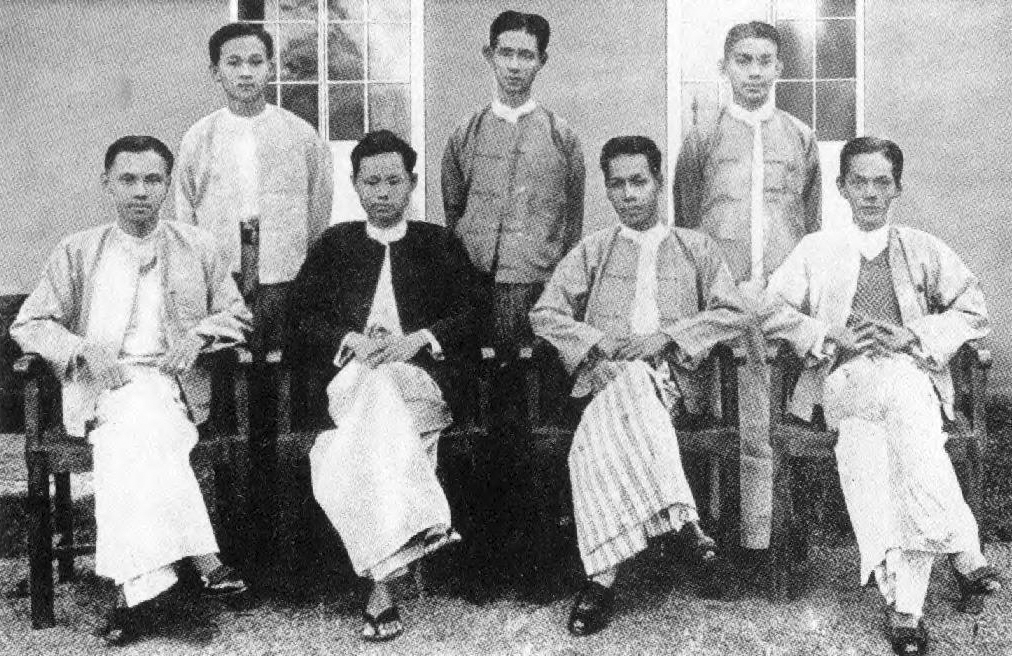|
Crown Prince Ka Naung
Kanaung Mintha ( my, ကနောင်မင်းသား; 31 January 1820 – 2 August 1866) was crown prince of Burma and son of King Tharrawaddy and younger brother of King Mindon of Burma. Towards the end of the Second Anglo-Burmese War, Kanaung and Mindon overthrew their half brother Pagan (1848–1853); Mindon ascended the throne and Kanaung became the Heir Apparent on 11 July 1853. He was the fiery "War Prince" and the peoples' idol. Kanaung attempted to modernize the country by sending scholars to Western countries and by founding an arms industry. However, his efforts were cut short when he was killed by his two nephews. Notwithstanding his short life, he is revered by Burmese nationals for his innovations in modernizing Burma. Role as a modernizer King Mindon was dedicated to religion, but Kanaung was skillful in administration, serving as the leader (, ''thamada'') of the Hluttaw, the kingdom's administrative body. Under Kanaung's guidance, the following reforms w ... [...More Info...] [...Related Items...] OR: [Wikipedia] [Google] [Baidu] |
Konbaung Dynasty
The Konbaung dynasty ( my, ကုန်းဘောင်ခေတ်, ), also known as Third Burmese Empire (တတိယမြန်မာနိုင်ငံတော်) and formerly known as the Alompra dynasty (အလောင်းဘုရားမင်းဆက်, Alaungphra dynasty) and the Hunter dynasty (မုဆိုးမင်းဆက် Mokso dynasty / မုဆိုးဘိုမင်းဆက် Moksobo dynasty), was the last dynasty that ruled Myanmar, Burma/Myanmar from 1752 to 1885. It created the second-largest empire in history of Myanmar, Burmese history and continued the administrative reforms begun by the Toungoo dynasty, laying the foundations of the modern state of Burma. The reforms, however, proved insufficient to stem the advance of the British Empire, British, who defeated the Burmese in all three Anglo-Burmese Wars over a six-decade span (1824–1885) and ended the millennium-old Burmese monarchy in 1885. An expansionist dynasty, the K ... [...More Info...] [...Related Items...] OR: [Wikipedia] [Google] [Baidu] |
Hluttaw
The Pyidaungsu Hluttaw ( my, ပြည်ထောင်စု လွှတ်တော် lit. Assembly of the Union) is the ''de jure'' national-level bicameral legislature of Myanmar (officially known as the ''Republic of the Union of Myanmar'') established by the 2008 National Constitution. The Pyidaungsu Hluttaw is made up of two houses, the Amyotha Hluttaw (House of Nationalities), a 224-seat upper house as well as the Pyithu Hluttaw, a 440-seat lower house (House of Representatives). Each of the fourteen major administrative regions and states has its own local Hluttaw: Region Hluttaw (Region Assembly) or State Hluttaw (State Assembly). The Pyidaungsu Hluttaw is housed in a 31-building parliamentary complex. It is believed to represent the 31 planes of existence in Buddhist cosmology, located in Zeya Theddhi Ward of Naypyidaw. Members of the second Pyidaungsu Hluttaw were elected in the 8 November 2015 general election. On 16 March 2012, parliamentarians made ... [...More Info...] [...Related Items...] OR: [Wikipedia] [Google] [Baidu] |
Konbaung Dynasty
The Konbaung dynasty ( my, ကုန်းဘောင်ခေတ်, ), also known as Third Burmese Empire (တတိယမြန်မာနိုင်ငံတော်) and formerly known as the Alompra dynasty (အလောင်းဘုရားမင်းဆက်, Alaungphra dynasty) and the Hunter dynasty (မုဆိုးမင်းဆက် Mokso dynasty / မုဆိုးဘိုမင်းဆက် Moksobo dynasty), was the last dynasty that ruled Myanmar, Burma/Myanmar from 1752 to 1885. It created the second-largest empire in history of Myanmar, Burmese history and continued the administrative reforms begun by the Toungoo dynasty, laying the foundations of the modern state of Burma. The reforms, however, proved insufficient to stem the advance of the British Empire, British, who defeated the Burmese in all three Anglo-Burmese Wars over a six-decade span (1824–1885) and ended the millennium-old Burmese monarchy in 1885. An expansionist dynasty, the K ... [...More Info...] [...Related Items...] OR: [Wikipedia] [Google] [Baidu] |
Hteiktin Ma Lat
Princess Limbin Hteiktin Ma Lat ( my, ထိပ်တင်မလတ်; 13 October 1894 – 1965), also Tin Tin Ma Lat, was a princess of Burma and one of the senior members of the Royal House of Konbaung. Biography Hteiktin Ma Lat was born on 13 October 1894 in Calcutta, British India. She was the second daughter of Limbin Mintha and his consort Kin Me (Yenatha Khin Khin Gyi), the princess of Limbin. She was the great-granddaughter of King Tharrawaddy and granddaughter of Prince Kanaung. She studied at Girl's High School in Allahabad, India; she was well-educated and spoke English fluently. Maurice Collis, a colonial judge and author, wrote in his 1938 book ''Trials in Burma'' of receiving a call from Ma Lat in 1928: "She sat on the sofa, a beautiful woman, in a blue silk skirt and a jacket of white lawn, her complexion corn-coloured, her eyes large and brilliant, and with exquisite hands." Crown Prince Wilhelm, after meeting her at the Allahabad Club, described her as the ... [...More Info...] [...Related Items...] OR: [Wikipedia] [Google] [Baidu] |
June Rose Bellamy
June Rose Bellamy, also Yadana Nat-Mei ( my, ရတနာနတ်မယ်; lit. Goddess of the Nine Jewels, 1 June 1932 – 1 December 2020) was the First Lady of Myanmar as the fourth wife of the 4th President of Burma Ne Win. She was a Burmese royal princess of Australian descent and the great-granddaughter of Prince Kanaung. Early life and career June Rose was born on 1 June 1932 in Rangoon, British Burma. She was the great-granddaughter of Prince Kanaung Mintha and granddaughter of Prince Limbin. She was the only daughter of Princess Hteiktin Ma Lat of Konbaung, and Herbert Bellamy, an Australian orchid collector long settled in Burma. She was educated at St Joseph's Convent School, Kalimpong, India, also educated in Rangoon, Burma. After the war, as a teenager, she wrote an essay for a competition called "The World We Want", sponsored by the New York Herald Tribune, which won a prize to visit the US along with 30 international students. She became a TV host in the Phili ... [...More Info...] [...Related Items...] OR: [Wikipedia] [Google] [Baidu] |
Ne Win
Ne Win ( my, နေဝင်း ; 10 July 1910, or 14 or 24 May 1911 – 5 December 2002) was a Burmese politician and military commander who served as Prime Minister of Burma from 1958 to 1960 and 1962 to 1974, and also President of Burma from 1962 to 1981. Ne Win was Burma's military dictator during the Socialist Burma period of 1962 to 1988. Ne Win founded the Burma Socialist Programme Party (BSPP) and overthrew the democratic Union Parliament of U Nu in the 1962 Burmese coup d'état, establishing Burma as a one-party socialist state under the Burmese Way to Socialism ideology. Ne Win was Burma's ''de facto'' leader as chairman of the BSPP, serving in various official titles as part of his military government, and was known by his supporters as U Ne Win. His rule was characterized by a non-aligned foreign policy, isolationism, one-party rule, economic stagnation and superstition. Ne Win resigned in July 1988 in response to the 8888 Uprising that overthrew the BSPP, ... [...More Info...] [...Related Items...] OR: [Wikipedia] [Google] [Baidu] |
Aung San
Aung San (, ; 13 February 191519 July 1947) was a Burmese politician, independence activist and revolutionary. He was instrumental in Myanmar's struggle for independence from British rule, but he was assassinated just six months before his goal was realized. Aung San is considered the founder of modern-day Myanmar and the Tatmadaw (the country's armed forces), and is commonly referred to by the titles "Father of the Nation", "Father of Independence", and "Father of the Tatmadaw". Devoted to ending British Colonial rule in Burma, Aung San founded or was closely associated with many Burmese political groups and movements and explored various schools of political thought throughout his life. He was a life-long anti-imperialist and studied socialism as a student. In his first year of university he was elected to the executive committee of the Rangoon University Students' Union and served as the editor of its newspaper. He joined the Thakin Society in 1938 and served as its gener ... [...More Info...] [...Related Items...] OR: [Wikipedia] [Google] [Baidu] |
Third Anglo-Burmese War
The Third Anglo-Burmese War ( my, တတိယ အင်္ဂလိပ် – မြန်မာစစ်, Tatiya Anggalip–Mran cac), also known as the Third Burma War, took place during 7–29 November 1885, with sporadic resistance continuing into 1887. It was the final of three wars fought in the 19th century between the Burmese and the British. The war saw the loss of sovereignty of an independent Burma under the Konbaung dynasty, whose rule had already been reduced to the territory known as Upper Burma, the region of Lower Burma having been annexed by the British in 1853, as a result of the Second Anglo-Burmese War. Following the war, Burma came under the rule of the British Raj as a province of British India. From 1937, the British governed Burma as a separate colony until Burma achieved independence as a republic in 1948. Background Following a succession crisis in Burma in 1878, the British Resident in Burma was withdrawn, ending official diplomatic relatio ... [...More Info...] [...Related Items...] OR: [Wikipedia] [Google] [Baidu] |
Traditional Burmese Calendar
A tradition is a belief or behavior (folk custom) passed down within a group or society with symbolic meaning or special significance with origins in the past. A component of cultural expressions and folklore, common examples include holidays or impractical but socially meaningful clothes (like lawyers' wigs or military officers' spurs), but the idea has also been applied to social norms such as greetings. Traditions can persist and evolve for thousands of years—the word ''tradition'' itself derives from the Latin ''tradere'' literally meaning to transmit, to hand over, to give for safekeeping. While it is commonly assumed that traditions have an ancient history, many traditions have been invented on purpose, whether that be political or cultural, over short periods of time. Various academic disciplines also use the word in a variety of ways. The phrase "according to tradition", or "by tradition", usually means that whatever information follows is known only by oral tradition, ... [...More Info...] [...Related Items...] OR: [Wikipedia] [Google] [Baidu] |
Yadaya
Yadaya ( my, ယတြာ, ; from Sanskrit ; variously spelt yadayar and yedaya) refers to magical rituals done to delay, neutralize or prevent misfortune, widely practiced in Myanmar (Burma). These rituals, which originate from Brahmanism, are guided and prescribed by soothsayers and astrologers, who use a combination of mathematical equations and astrology to formulate a "prescription" to avert misfortune. Modern Burmese leaders, including U Nu, Ne Win and Than Shwe and many government policy decisions are widely understood to have been influenced by yadaya rituals. Among Burmese Buddhists, yadaya is often linked to merit-making, as some prescriptive rituals involve seemingly "Buddhist" acts, although they are done to bypass karmic fate, which cannot be altered by ritual in Buddhist doctrine. Yadaya is closely associated to numerology, particularly the number nine, which is widely believed to be an auspicious number. Some scholars contend that yadaya originates to the Pagan perio ... [...More Info...] [...Related Items...] OR: [Wikipedia] [Google] [Baidu] |
Statute Of Kanaung Mintha
A statute is a formal written enactment of a legislative authority that governs the legal entities of a city, state, or country by way of consent. Typically, statutes command or prohibit something, or declare policy. Statutes are rules made by legislative bodies; they are distinguished from case law or precedent, which is decided by courts, and regulations issued by government agencies. Publication and organization In virtually all countries, newly enacted statutes are published and distributed so that everyone can look up the statutory law. This can be done in the form of a government gazette which may include other kinds of legal notices released by the government, or in the form of a series of books whose content is limited to legislative acts. In either form, statutes are traditionally published in chronological order based on date of enactment. A universal problem encountered by lawmakers throughout human history is how to organize published statutes. Such publications ha ... [...More Info...] [...Related Items...] OR: [Wikipedia] [Google] [Baidu] |
Sangha (Buddhism)
Sangha is a Sanskrit word used in many Indian languages, including Pali meaning "association", "assembly", "company" or "community"; Sangha is often used as a surname across these languages. It was historically used in a political context to denote a governing assembly in a republic or a kingdom, and has long been used by religious associations including the Buddhists, Jains and Sikhs. Given this history, some Buddhists have said the tradition of the ''sangha'' represents humanity's oldest surviving democratic institution. In Buddhism, ''sangha'' refers to the monastic community of ''bhikkhu'' (monks) and '' bhikkhuni'' (nuns). These communities are traditionally referred to as the ''bhikkhu-sangha'' or ''bhikkhuni-sangha''. As a separate category, those who have attained any of the four stages of enlightenment, whether or not they are members of the monastic community, are referred to as the ''āryasaṅgha'' ("noble Sangha"). According to the Theravada school and Nichir ... [...More Info...] [...Related Items...] OR: [Wikipedia] [Google] [Baidu] |











